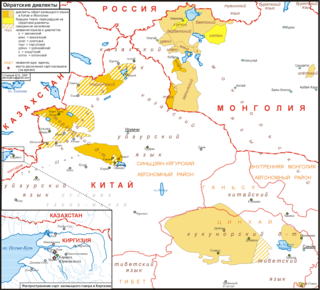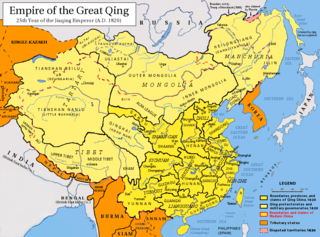
The Mongols are an East Asian ethnic group native to Mongolia, China, as well as Buryatia and Kalmykia of Russia. The Mongols are the principal member of the large family of Mongolic peoples. The Oirats in Western Mongolia as well as the Buryats and Kalmyks of Russia are classified either as distinct ethno-linguistic groups or subgroups of Mongols.

This article on the demographics of Mongolia include population density, ethnicity, education level, health of the populace, economic status, religious affiliations, and other aspects of the population.

The Mongolic languages are a language family spoken by the Mongolic peoples in Eastern Europe, Central Asia, North Asia and East Asia, mostly in Mongolia and surrounding areas and in Kalmykia and Buryatia. The best-known member of this language family, Mongolian, is the primary language of most of the residents of Mongolia and the Mongol residents of Inner Mongolia, with an estimated 5.7+ million speakers.

Kalmyks are the only Mongolic-speaking people living in Europe, residing in the easternmost part of the European Plain.

The Dongxiang people are a Mongolic people and one of 56 ethnic groups officially recognized by the People's Republic of China. Half of the population live in Dongxiang Autonomous County, Linxia Prefecture, Gansu Province, China. The rest are divided over Hezheng County, Linxia City, Lanzhou, Dingxi and Ningxia. According to the 2010 census, their population numbers 621,500, although research has found that the number is inflated due to Hui identifying themselves as Dongxiang for the census, in order to benefit from minority policies.

Oirats or Oirds, also formerly Eluts and Eleuths, are the westernmost group of the Mongols whose ancestral home is in the Altai region of Siberia, Xinjiang and western Mongolia.

The Dörbet is the second largest subgroup of Mongol people in modern Mongolia and was formerly one of the major tribes of the Four Oirat confederation in the 15th-18th centuries. In early times, the Dörbets and the Öold were overruled by collateral branches of the Choros lineage. The Dörbets are distributed among the western provinces of Mongolia, Kalmykia and in a small portion in Heilongjiang, China. In modern-day Mongolia, the Dörbets are centered in Uvs Province.

Oirat is a Mongolic language spoken by the descendants of Oirat Mongols, now forming parts of Mongols in China, Kalmyks in Russia and Mongolians. Largely mutually intelligible to other core Central Mongolic languages, scholars differ as to whether they regard Oirat as a distinct language or a major dialect of the Mongolian language. Oirat-speaking areas are scattered across the far west of Mongolia, the northwest of China and Russia's Caspian coast, where its major variety is Kalmyk. In China, it is spoken mainly in Xinjiang, but also among the Deed Mongol of Qinghai and Subei County in Gansu.

Mongols in China, also known as Mongolian Chinese, are ethnic Mongols who live in China. They are one of the 56 ethnic groups recognized by the Chinese government.

Xinjiang is historically consisted of two main geographically, historically, and ethnically distinct regions with different historical names: Dzungaria north of the Tianshan Mountains; and the Tarim Basin south of the Tianshan Mountains, currently mainly inhabited by the Uyghurs. They were conquered by the Qing dynasty in the 18th century, and after the Dungan Revolt (1862–1877) the Qing reconquered both regions and integrated them into one province named Xinjiang in 1884.

Hoboksar, sometimes referred with the historic name Hefeng County, is an autonomous county for Mongol people in the middle north of Xinjiang Uyghur Autonomous Region, Western China, it is under the administration of Tacheng Prefecture. The county has an area of 28,784 km2 (11,114 sq mi) with a population of 62,100. It has eight towns and townships and seven farms, Hoboksar Town is its county seat.

Islam in Mongolia is practiced by approximately 3 to 5% of the population. It is practised by the ethnic Kazakhs of Bayan-Ölgii Province and Khovd Province aimag in western Mongolia. In addition, a number of small Kazakh communities can be found in various cities and towns spread throughout the country. Islam is also practiced by the smaller communities of Khotons and Uyghurs.

Kazakhs are a Turkic ethnic group and one of the 56 ethnic groups officially recognized by the People's Republic of China. There is one Kazakh autonomous prefecture – Ili in Xinjiang – and three Kazakh autonomous counties – Aksay in Gansu, and Barkol and Mori in Xinjiang.

The Dzungar people are the many Mongol Oirat tribes who formed and maintained the Dzungar Khanate in the 17th and 18th centuries. Historically, they were one of the major tribes of the Four Oirat confederation. They were also known as the Eleuths or Ööled, from the Qing dynasty euphemism for the hated word "Dzungar", and as the "Kalmyks". In 2010, 15,520 people claimed "Ööled" ancestry in Mongolia. An unknown number also live in China, Russia and Kazakhstan.
Khoton is a dialect of Uyghur language in the Karluk group of Turkic languages. Khoton learners are decreasing every year and considered an extinct language. Khotons use Oirat dialect of Mongolic languages in daily life.
The Sart Kalmyks are an ethnic group of the Oirats, who live in Issyk Kul Province, Kyrgyzstan. Their population is estimated to be c. 12,000. They are descendants of the Ööled tribes, who moved to the territory of the Russian Empire after the failure of the Dungan revolt, some part inhabited the area during the rule of the Zunghar Khanate. They used to speak Sart Kalmyk, a dialect of the Oirat language, but have largely switched to the Kyrgyz language by now. As a result of their long co-inhabitance with Kyrgyz people, they have largely incorporated into the Kyrgyz nation, though some Kyrgyz still consider them to be distinct. Today the majority of Sart Kalmyks also identify themselves as Kyrgyz, or as "almost Kyrgyz". They belong to the Muslim faith.

Migration to Xinjiang is both an ongoing and historical movement of people, often sponsored by various states who controlled the region, including the Han dynasty, Tang dynasty, Uyghur Khaganate, Yuan dynasty, Qing dynasty, Republic of China and People's Republic of China.
Anti-Mongolianism, also called anti-Mongolian sentiment, has been prevalent throughout history, often perceiving the Mongols to be barbaric and uncivilized people with a lack of intelligence or civilized culture.

The Qing dynasty in Inner Asia was the expansion of the Qing dynasty's realm in Inner Asia in the 17th and the 18th century AD, including both Inner Mongolia and Outer Mongolia, both Manchuria and Outer Manchuria, Tibet, Qinghai and Xinjiang.














